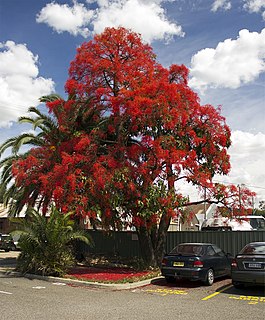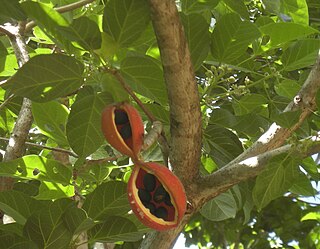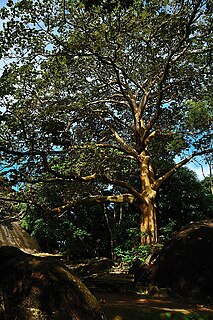
A mosquito is any member of a group of about 3,500 species of small insects belonging to the order Diptera (flies). Within Diptera, mosquitoes constitute the family Culicidae. The word "mosquito" is Spanish and Portuguese for "little fly". Mosquitoes have a slender segmented body, one pair of wings, one pair of halteres, three pairs of long hair-like legs, and elongated mouthparts.

The zebra finch is the most common estrildid finch of Central Australia and ranges over most of the continent, avoiding only the cool moist south and some areas of the tropical far north. It can also be found natively on Timor island. The bird has been introduced to Puerto Rico and Portugal.

The spotted turtle, the only species of the genus Clemmys, is a small, semi-aquatic turtle that reaches a carapace length of 8–12 cm (3.1–4.7 in) upon adulthood. Their broad, smooth, low dark-colored upper shell, or carapace, ranges in its exact colour from black to a bluish black with a number of tiny yellow round spots. The spotting patterning extends from the head, to the neck and out onto the limbs. Sexually mature males have a concave plastron and a long, thick tail. By contrast, sexually mature females possess a flat plastron and have a tail notable shorter and thinner than mature males. Mature males also have a dark iris and face; females typically have a yellow or orange iris and a similarly coloured face that is distinctly lighter than males. Juveniles appear female-like in this regard and at maturity males begin to develop darker features.

Aedes aegypti, the yellow fever mosquito, is a mosquito that can spread dengue fever, chikungunya, Zika fever, Mayaro and yellow fever viruses, and other disease agents. The mosquito can be recognized by white markings on its legs and a marking in the form of a lyre on the upper surface of its thorax. This mosquito originated in Africa, but is now found in tropical, subtropical and temperate regions throughout the world.

Erythranthe guttata, with the common names seep monkeyflower and common yellow monkeyflower, is a yellow bee-pollinated annual or perennial plant. It was formerly known as Mimulus guttatus.

Sterculia is a genus of flowering plants in the mallow family, Malvaceae: subfamily Sterculioideae. Members of the genus are colloquially known as tropical chestnuts. The scientific name is taken from Sterculius of Roman mythology, who was the god of manure; this is in reference to the unpleasant aroma of the flowers of this genus. Sterculia may be monoecious or dioecious, and flowers unisexual or bisexual.

Elaphe is a genus of snakes in the family Colubridae. Elaphe is one of the main genera of the rat snakes, which are found in many regions of the northern hemisphere. Elaphe species are medium to large constrictors by nature. Although all of the species in Elaphe are nonvenomous, bites from rat snakes are still irritably painful and can potentially cause bacterial infections due to the saliva.

The pale-billed flowerpecker or Tickell's flowerpecker is a tiny bird that feeds on nectar and berries, found in India, Sri Lanka, Bangladesh and western Myanmar. The bird is common especially in urban gardens with berry bearing trees. They have a rapid chipping call and the pinkish curved beak separates it from other species in the region.

Brachychiton acerifolius is a large tree of the family Malvaceae endemic to tropical and subtropical regions on the east coast of Australia. It is famous for the bright red bell-shaped flowers that often cover the whole tree when it is leafless. It is commonly known as the flame tree, Illawarra flame tree, lacebark tree, or kurrajong.

Tuberaria guttata, the spotted rock-rose or annual rock-rose, is an annual plant of the Mediterranean region which also occurs very locally in Wales and Ireland. The flowers are very variable with the characteristic spot at the base of the petal very variable in size and intensity of colour.

Sterculia quadrifida, also known as the peanut tree, or red-fruited kurrajong is a small tree that grows in the rainforests, vine thickets, and gallery forests of coastal Queensland, the Northern Territory and north-eastern New South Wales.

Brachychiton rupestris, commonly known as the narrow-leaved bottle tree or Queensland bottle tree, is a tree in the family Malvaceae native to Queensland, Australia. Discovered and described by Sir Thomas Mitchell and John Lindley in 1848, it gained its name from its bulbous trunk, which can be up to 3.5 metres (11 ft) diameter at breast height (DBH). Reaching 10–25 metres (33–82 ft) high, the Queensland bottle tree is deciduous, losing its leaves between September and December. The leaves are simple or divided, with one or more narrow leaf blades up to 11 centimetres (4 in) long and 2 centimetres (0.8 in) wide. Cream-coloured flowers appear from September to November, and are followed by woody boat-shaped follicles that ripen from November to May. No subspecies are recognised.

Scaphium affine is a tree species in the family Malvaceae, subfamily Sterculioideae. It is native to mainland Southeast Asia and no subspecies are listed in the Catalogue of Life.

Copiula guttata is a species of frog in the family Microhylidae. It is endemic to Papua New Guinea and known from around the head of the Gulf of Papua in the Gulf and Chimbu Provinces. The specific name is the Latin adjective guttata that means "spotted" and refers to the dorsal colour pattern of this species. Based on molecular evidence, it was transferred from Austrochaperina to Copiula in 2016.

Parnara bada, the African straight swift, grey swift or Ceylon swift, is a butterfly of the family Hesperiidae. It is found in south-east Asia, from India through China to Indonesia, as well as the north-east coast of Australia.

Sterculia apetala, commonly known as the Panama tree, camoruco, manduvi tree or anacagüita, is a species of flowering plants in the family Malvaceae. It is found in Central and South America, as well as the Caribbean islands. Sterculia apetala is recognized as the national tree of the Republic of Panama.

Sterculia foetida is a soft wooded tree that can grow up to 35 metres tall. It was described in 1753 by Carl Linnaeus. Common names for the plant are the bastard poon tree, java olive tree, hazel sterculia, wild almond tree, and skunk tree. This is the type species of the genus Sterculia and both names mean bad-smelling: the name Sterculia comes from Sterquilinus, the Roman god of fertilizer or manure.

Sterculia urens is a species of plant in the family Malvaceae. It is native to India and has been introduced into Burma. A small to medium-sized tree with a pale-coloured trunk, it is commonly known as the भुत्या in Marathi, kulu, Indian tragacanth, gum karaya, katira, sterculia gum or kateera gum. The specific name urens refers to the stinging hairs present on the flowers.

West Nile virus (WNV) is a single-stranded RNA virus that causes West Nile fever. It is a member of the family Flaviviridae, specifically from the genus Flavivirus, which also contains the Zika virus, dengue virus, and yellow fever virus. West Nile virus is primarily transmitted by mosquitoes, mostly species of Culex. The primary hosts of WNV are birds, so that the virus remains within a "bird–mosquito–bird" transmission cycle. The virus is genetically related to the Japanese encephalitis family of viruses.

Erythranthe peregrina is a species of monkeyflower. Its Latin name means "foreign", or more loosely "the foreigner". This species is a rare example of polyploidization and speciation where sterility did not occur. It was discovered in 2011, first reported in 2012, and named Mimulus peregrinus. Around the same time, the genus Mimulus was restructured and this species is now called Erythranthe peregrina and is in the section Simiolus. The species was less than 140 years old at the time of discovery in 2011; its discoverer, Mario Vallejo-Marin of the University of Stirling, compared finding it to "looking at the big bang in the first milliseconds of its occurrence".




















